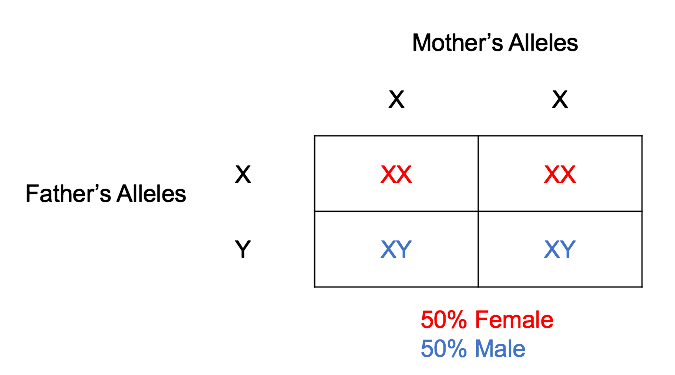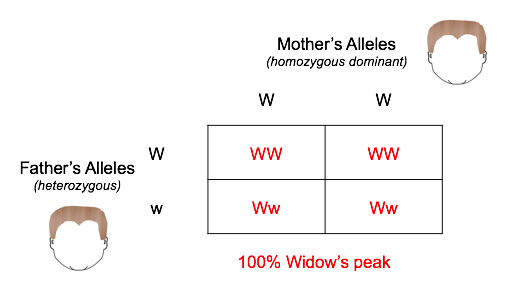Table of Contents |
Punnett squares are tools that are used to determine the probability or the chance that a trait will show up in an offspring. Genetic traits are characteristics of an organism that are determined by their genes and are inherited.
EXAMPLE
An example of a trait could be eye color, height, hair color, or certain genetic disorders.A Punnett square helps determine the odds of an offspring’s genotype given the parent’s genotype. Ultimately, genotype will determine the phenotype.
To see how Punnett squares are used, look at this square crossing male and female sex chromosomes:

The Punnett square crosses the sex alleles of a male and a female. A female will have two X chromosome, and a male will have an X and a Y chromosome. The mother’s alleles are listed on top, and the fathers are listed on the side.
Below is a Punnett square related to a hairline showing whether a person is going to have a straight hairline or a widow's peak. A widow's peak is a dominant trait; if a person has at least one dominant allele (W), they will have the widow's peak.

The mom in this example is homozygous dominant for widow's peak. This means that she has the same alleles (W and W), and both are dominant. Her phenotype would be the dominant trait, which is this case means she has a widow’s peak.
The father is heterozygous for the trait, meaning that he has one dominant allele (W) and one recessive allele (w). Since he has at least one dominant allele, it masks that recessive allele. The dad will also have a widow's peak as his phenotype.
Recall how gametes are made: In meiosis I, both sister chromatids of one homolog goes to daughter cell A, and both sister chromatids of the other homolog goes to daughter cell B. For each of the 23 homologous pairs of chromosomes, it's random which homolog goes where. That means that genes on separate chromosomes may or may not be inherited together.
EXAMPLE
If you inherited an allele for green eyes and an allele for sickle cell anemia from your father, and the allele for brown eyes and the allele for normal hemoglobin from your mother. each of your children might have green eyes and sickle cell anemia, or brown eyes and sickle cell anemia, or green eyes and normal hemoglobin, or brown eyes and normal hemoglobin.The law of independent assortment is a law that states that the vast majority of traits are inherited independently of one another. This means that the inheritance of one trait is not influenced by the inheritance of another trait.
EXAMPLE
The inheritance of a Y chromosome does not influence, or is not dependent on, the inheritance of a widow's peak, for example. So traits are inherited independently of one another.Source: THIS WORK IS ADAPTED FROM SOPHIA AUTHOR AMANDA SODERLIND